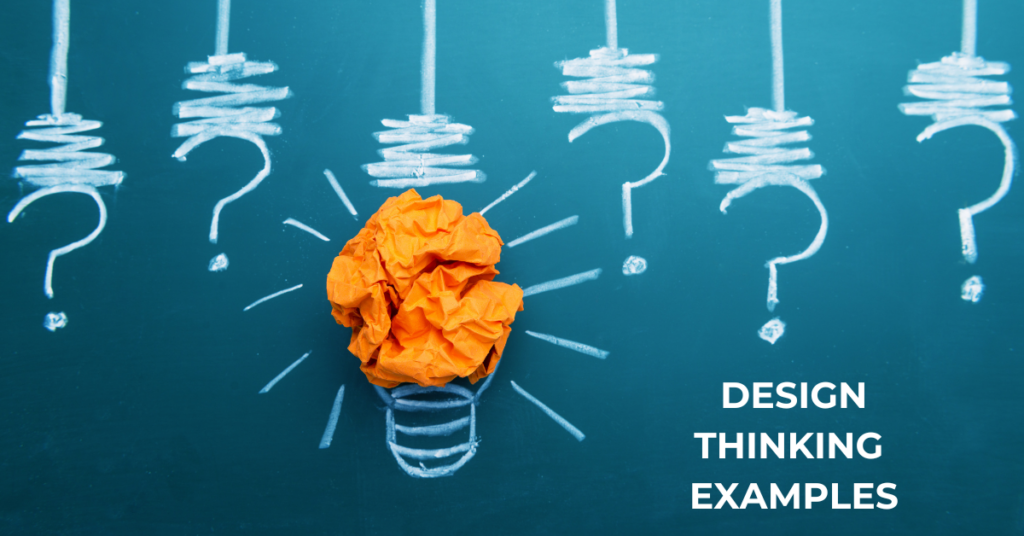Product Management 101: Top 10 Successful Design Thinking Example Case Studies

- What is Design Thinking, and How Does it Benefit Product Development?
- How Can Design Thinking Help Create Innovative Products?
- What are Some Key Principles of Design Thinking in Product Development?
- A Design Thinking Example Round-Up: Iconic Products That Were Developed Using Design Thinking
- How Can Product Professionals Incorporate Design Thinking Into Their Work?
According to a 2022 report titled Design Thinking: A Global Study on Implementation Practices in Organizations, design thinking is applied across diverse industries. For instance, apart from the information and communications sector, design thinking has witnessed a 140% growth in manufacturing, finances and insurance saw an 86% increase, and health care experienced a staggering 250% surge in its adoption. So, are you curious about the secret behind transforming simple concepts into industry-defining products? This blog navigates the intricate world of design thinking, highlighting ten successful design thinking example case studies that have redefined innovation and product development standards.
What is Design Thinking, and How Does it Benefit Product Development?
A. What is Design Thinking?
Sarah Critchley, the director of strategy and growth at Hitachi Solutions, encapsulates design thinking perfectly: “Design thinking is a process that puts a human being, or a group of humans, at the center of an identified problem. It then focuses on methods that help get to the root of what is actually, truly, going on for them and asks questions like what are their problems and concerns? What are their thoughts?” Expanding on this, design thinking is a methodology that empowers teams to approach product development with a user-centric design mindset. Additionally, it encourages an iterative process where solutions evolve through empathy, ideation, prototyping, and testing. Hence, design thinking becomes pivotal to successful product design.
B. What are the Benefits of Design Thinking?
1. Customer Satisfaction
First and foremost, design thinking significantly elevates customer satisfaction. This approach places user needs at the forefront. Thus, products become more aligned with what users truly want. Consequently, this alignment leads to higher satisfaction rates.
2. Improvement in Efficiency
Teams become more efficient when they adopt design thinking. This is because the iterative nature of design thinking allows for rapid prototyping and feedback loops. Consequently, this process speeds up the product development process significantly. Furthermore, efficiency gains are not just in time saved but also in the quality of the outcomes.
3. Boosting Innovation
Design thinking also stands at the forefront of innovation in products. The “Design Thinking: A Global Study on Implementation Practices in Organizations” report underscores this, revealing that 55% of R&D teams leverage design thinking. This methodology encourages out-of-the-box thinking and leads to groundbreaking solutions that redefine markets.
4. Better Collaboration
Lastly, design thinking enhances collaboration among cross-functional teams and combines diverse perspectives and expertise to create holistic solutions. Design principles advocate for inclusivity and diversity of thought. This approach ensures that all aspects of a user’s experience are considered.
ALSO READ: Top 5 Ways How Product Management Courses Impact Earning Potential
How Can Design Thinking Help Create Innovative Products?

Design thinking plays a key role when it comes to innovation in products, guiding teams through a journey from the spark of an idea to the final execution. For instance, this methodology embeds user-centric design principles at every stage, ensuring that products meet even exceed user expectations. By fostering an environment where questioning the status quo is encouraged, design thinking propels teams to explore problems from entirely new perspectives. Moreover, this approach ensures that the product development process is imbued with creativity and innovation.
Furthermore, design thinking emphasizes the importance of empathy, allowing designers to step into the users’ shoes and truly understand their needs and frustrations. This deep understanding is crucial for successful product design, as it ensures that solutions are not just innovative but also highly relevant and valuable to the end user.
What are Some Key Principles of Design Thinking in Product Development?
1. Clarity
Initially, teams dive deep into understanding user needs. This phase is critical, as it sets the foundation for user-centric design. By engaging directly with users, teams can uncover insights that are not immediately obvious. Moreover, this deep dive helps ensure that the product development process is aligned with real user problems and aspirations, making it a pivotal step toward successful product design.
2. Ideation
After clarity comes ideation. At this stage, teams are encouraged to think beyond conventional solutions and explore various possibilities. This unrestricted brainstorming session is vital for sparking innovation in products.
3. Development
In this phase, the team works on turning their brainstormed ideas into early models, known as prototypes. These prototypes are practical, scaled-down versions of the product that showcase how it could work in real life. This step is essential for checking if the ideas are workable. Creating prototypes is a key part of the design thinking process because it allows the team to see potential problems and figure out solutions before the final product is made
4. Implementation
Finally, the implementation phase marks the transition of prototypes into full-fledged products. Successful product design is materialized in this stage as products are launched and reach their end users. The implementation phase is not the end but a new beginning, where user feedback can lead to further iterations.
ALSO READ: Top 10 Product Management Trends to Watch Out for in 2024
A Design Thinking Example Round-Up: Iconic Products That Were Developed Using Design Thinking
1. Oral B: Innovating Dental Care Through Design Thinking
Oral B redefined electric toothbrushes by focusing on user needs rather than adding complex features. Importantly, this design thinking example illustrates how simplifying the charging process and integrating reminders for brush-head replacement directly addressed consumer convenience and dental health.
2. GE Healthcare: Transforming Patient Experience With Design Thinking
GE Healthcare utilized design thinking to make MRI scans less intimidating for children, creating the “Adventure Series” MRI machines. Consequently, this approach significantly improved patient satisfaction by turning a scary procedure into an adventurous experience, showcasing the impact of empathy in product development. This design thinking example exhibits the importance of addressing user needs in innovation in health care.
3. Netflix: Pioneering Streaming Services Through Design Thinking
Netflix reshaped the entertainment industry by introducing a subscription-based model that eliminated the need for physical DVD rentals. Thus, this design thinking example illustrates how understanding and addressing customer pain points can lead to the development of iconic products.
4. Airbnb: Reimagining Hospitality With Design Thinking
Airbnb transformed the lodging industry by focusing on high-quality photographs to attract more customers. This strategy, rooted in design thinking, demonstrates the power of simple yet effective solutions in enhancing user-centric design.
5. Apple: Setting Industry Standards Through Design Thinking
Apple’s commitment to design thinking has resulted in iconic products that blend technology with user-friendly interfaces. Consequently, this approach has not only solidified Apple’s market dominance but also emphasized the importance of design principles in creating successful product design.
ALSO READ: How to Become a Digital Product Manager? Learn These Top 5 Skills
6. Uber Eats: Redefining Food Delivery With Design Thinking
Uber Eats applied design thinking to understand the intricacies of food delivery, from restaurant operations to customer preferences. Thus, Uber’s insights into user experience led to innovative features that set it apart in the competitive food delivery landscape.
7. IBM: Leveraging Design Thinking for Technological Innovation
IBM showcases design thinking by integrating it into its corporate culture, leading to innovative solutions that address complex business challenges. Hence, this design thinking example emphasizes the role of design thinking in fostering collaboration and creativity across various sectors.
8. Nike: Driving Sports Innovation Through Design Thinking
Nike’s application of design thinking has led to products that combine performance with style, meeting athletes’ needs while appealing to fashion sensibilities. This design thinking example illustrates how continuous user engagement and feedback can inspire innovation in products.
9. Clean Team: Addressing Sanitation Challenges With Design Thinking
The Clean Team Project uses design thinking to tackle sanitation issues in Ghana, thus highlighting the methodology’s potential for social impact. By focusing on user needs, Clean Team developed a sustainable sanitation solution that improved living conditions for many.
10. Bank of America: Reinventing Banking Services Through Design Thinking
Finally, Bank of America’s “Keep the Change” program is a prime design thinking example of how understanding customer behavior can lead to innovative banking solutions. For instance, this initiative not only encouraged savings but also strengthened customer relationships, showcasing the versatility of design thinking in various industries.
ALSO READ: What is Descriptive Design and Why is It Important: The Ultimate Guide
How Can Product Professionals Incorporate Design Thinking Into Their Work?
Product professionals can seamlessly integrate design thinking into their workflow by prioritizing the user at every step. Initially, they must understand the user’s environment, challenges, and desires. Because this user-focused mindset is crucial for identifying genuine needs that may not be immediately apparent. Furthermore, embracing rapid prototyping becomes essential. By quickly turning ideas into tangible prototypes, professionals can test concepts in real-world scenarios, gathering invaluable feedback early in the product development process. Iterative testing follows, where each prototype undergoes rigorous evaluation based on user interactions. This cycle of testing and refinement ensures that the final product matches user expectations.
Design thinking proves crucial for modern organizations, driving productivity, user satisfaction, and return on investment. Moreover, from service designer project manager to business analyst—knowledge of design thinking opens doors to diverse job opportunities. For those eager to dive deeper into design principles, Emeritus offers tailored product management courses to elevate your career.
Write to us at content@emeritus.org






